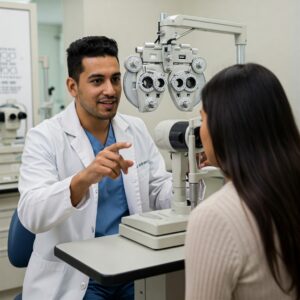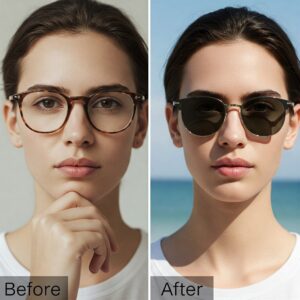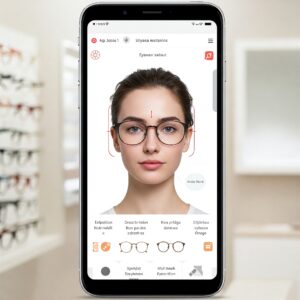Introduction
When it comes to your vision, settling for anything less than perfect isn’t an option. Yet many people purchase glasses without professional guidance, often ending up with eyewear that doesn’t fully address their needs. The optometrist eyewear selection process involves multiple steps to ensure perfect fit and function. These eye care professionals bring specialized knowledge that extends far beyond basic vision testing.
 Optometrists are healthcare professionals who have completed extensive education—typically four years of optometry school after undergraduate studies—specializing in eye health, vision testing, and corrective solutions. This expertise allows them to detect subtle vision issues that might be missed in quick vision screenings or online tests. Modern prescription glasses offer more than just vision correction—they’re tailored to your unique needs by optometrists who understand the complex relationship between your eyes, your lifestyle, and your eyewear.
Optometrists are healthcare professionals who have completed extensive education—typically four years of optometry school after undergraduate studies—specializing in eye health, vision testing, and corrective solutions. This expertise allows them to detect subtle vision issues that might be missed in quick vision screenings or online tests. Modern prescription glasses offer more than just vision correction—they’re tailored to your unique needs by optometrists who understand the complex relationship between your eyes, your lifestyle, and your eyewear.
The Science Behind Professional Eyeglasses Selection
Customization of Eyewear
Professional eyeglasses selection takes into account both medical requirements and aesthetic preferences. Optometrists don’t just hand you a prescription and send you to choose frames. Instead, they engage in a detailed process that ensures your eyewear addresses your specific vision challenges while providing optimal comfort and functionality.
The customization process begins with precise measurements. Beyond the standard prescription parameters of sphere, cylinder, and axis, optometrists measure:
- Pupillary distance (PD) – the exact distance between your pupils
- Optical center height – where your eyes align with the lenses
- Vertex distance – the space between your eye and the back of the lens
- Pantoscopic tilt – the vertical angle of your glasses relative to your face
These measurements might seem minor, but they significantly impact vision quality. For instance, an incorrect pupillary distance can cause eye strain, headaches, and distorted vision—even with the right prescription.  Advanced technologies like the ZEISS VISUFIT 1000 capture 45 million data points per scan, creating a 3D model of your face for perfect frame fitting.
Advanced technologies like the ZEISS VISUFIT 1000 capture 45 million data points per scan, creating a 3D model of your face for perfect frame fitting.
Lifestyle Considerations
Optometrists consider selective eyewear elements like lens coatings and frame materials based on your daily activities. During your consultation, your optometrist will ask detailed questions about:
- Your occupation and work environment
- Digital device usage patterns
- Hobbies and recreational activities
- Driving habits and requirements
- Sports participation
These factors directly influence recommendations for lens types, coatings, and frame materials. For example, someone who spends 8+ hours daily on a computer might benefit from blue light filtering lenses and an anti-reflective coating to reduce digital eye strain. Meanwhile, an outdoor enthusiast might need  photochromic lenses that darken in sunlight and frames made from durable, lightweight materials.
photochromic lenses that darken in sunlight and frames made from durable, lightweight materials.
Thoughtful lifestyle eyewear recommendations take into account your work environment, hobbies, and daily routines. This personalized approach ensures your glasses enhance rather than hinder your activities, providing optimal vision in all the environments where you need it most.
How Optometrists Ensure Prescription Glasses Meet Your Needs
The journey to perfect eyewear begins with a comprehensive eye examination. This isn’t just about determining your prescription—it’s a thorough assessment of your overall eye health and visual function. During this exam, your optometrist will:
- Evaluate your visual acuity at various distances
- Assess how your eyes work together
- Check your peripheral vision
- Measure your eye pressure
- Examine the health of your retina and optic nerve
- Determine your exact prescription needs
This detailed examination provides the foundation for all eyewear recommendations. Quality optometrist eyewear is designed to address specific vision challenges while providing maximum comfort.  The prescription itself is just the starting point—how that prescription is implemented through lens design, material selection, and frame fitting is equally important.
The prescription itself is just the starting point—how that prescription is implemented through lens design, material selection, and frame fitting is equally important.
Modern vision correction eyewear incorporates advanced technologies for clearer sight in all conditions. These innovations include:
- Digital free-form lenses that reduce distortion
- High-index materials for thinner, lighter lenses
- Progressive designs that eliminate visible lines
- Specialized coatings for durability and clarity
Your optometrist stays current with these advancements, ensuring you benefit from the latest developments in vision technology.
Understanding Selective Eyewear Elements for Different Lifestyles
Key Factors in Optometrist Glasses Selection
The optometrist glasses selection process begins with a comprehensive eye examination.  Following this assessment, several key factors guide the selection of appropriate eyewear:
Following this assessment, several key factors guide the selection of appropriate eyewear:
- Prescription Complexity: Different lens designs work better for certain prescriptions. High prescriptions might require special considerations for lens thickness and frame selection.
- Facial Anatomy: The shape of your face, nose bridge, and ear position all influence which frames will fit comfortably and look balanced.
- Lens Technology Needs: Based on your activities, you might benefit from specialized lens technologies like progressive designs, office lenses, or sports-specific options.
- Durability Requirements: Your daily activities determine whether you need highly durable materials or if lightweight comfort is the priority.
- Style Preferences: While function comes first, aesthetics matter too. Your optometrist helps find frames that complement your features while meeting technical requirements.
By considering these factors together, optometrists create a complete eyewear solution rather than just a vision correction device.
Boerne Success Stories with Customized Eyewear Solutions
Case Study 1: The Digital Professional
A 34-year-old software developer, spent 10+ hours daily looking at screens. He suffered from persistent headaches, dry eyes, and difficulty sleeping.  During his consultation, his optometrist discovered mild astigmatism and signs of digital eye strain.
During his consultation, his optometrist discovered mild astigmatism and signs of digital eye strain.
Solution: His optometrist prescribed glasses with a specialized blue light filter, slight magnification for computer distance, and an anti-reflective coating. The frames selected were lightweight titanium with adjustable nose pads for all-day comfort.
Case Study 2: The Competitive Athlete
A 28-year-old tennis player, struggled with his existing glasses during matches. They would slip during quick movements, fog up during exertion, and didn’t provide adequate peripheral vision.
Solution: His optometrist recommended sports-specific eyewear with impact-resistant polycarbonate lenses, a wrap-around design for peripheral vision, and anti-fog coating.  The frames included an adjustable strap system for secure fit during intense activity.
The frames included an adjustable strap system for secure fit during intense activity.
Case Study 3: The Active Senior
A senior woman, was struggling with her progressive lenses. Reading menus in restaurants,  working in her garden , and driving at night had all become challenging despite having recently purchased new glasses from an online retailer.
working in her garden , and driving at night had all become challenging despite having recently purchased new glasses from an online retailer.
Solution: Her optometrist conducted detailed measurements and discovered his previous glasses had incorrect optical centers and a frame that was too small for proper progressive lens function. The new prescription included optimized progressive lenses with enhanced night vision properties and proper fitting frames.
Patients report significant improvements in daily life after receiving customized eyewear solutions from their optometrist. These real-world examples demonstrate how professional eyewear selection addresses specific challenges that generic or online options often miss.
The Process of Optometrist Eyewear Fitting and Customization
What to Expect During Professional Eyewear Fitting
A professional eyewear fitting ensures your glasses work optimally for your unique facial structure. The fitting process typically includes:
- Frame Selection Guidance: Your optometrist or trained optician will recommend frames that complement your face shape, suit your prescription requirements, and meet your lifestyle needs.
- Precise Measurements: Using both traditional techniques and advanced digital tools, they’ll take detailed measurements including:
- Pupillary distance (PD)
- Segment height for bifocal or progressive lenses
- Vertex distance
- Pantoscopic angle
- Wrap angle
- Material Consultation: Based on your prescription and needs, your eye care professional will discuss lens material options, considering factors like:
- Thickness and weight
- Impact resistance
- Optical clarity
- UV protection
- Light sensitivity
- Lens Treatment Selection: You’ll receive recommendations for coatings and treatments that enhance performance and durability:
- Anti-reflective coatings
- Scratch-resistant treatments
- UV protection
- Blue light filtering
- Photochromic options
- Initial Fitting and Adjustments: Once your glasses are ready, your optometrist will ensure they fit perfectly, making precise adjustments to:
- Temple length and bend
- Bridge fit
- Frame alignment
- Weight distribution
This comprehensive process typically takes 30-45 minutes but results in eyewear that functions optimally for your specific needs.
The Importance of Follow-Up Care
The relationship with your optometrist doesn’t end when you pick up your new glasses.  Follow-up care is essential to ensure your eyewear continues to meet your needs over time.
Follow-up care is essential to ensure your eyewear continues to meet your needs over time.
Most optometrists recommend returning for adjustments after wearing your new glasses for 1-2 weeks. During this period, you’ll notice any areas of discomfort or vision issues that weren’t immediately apparent. Minor adjustments can make a significant difference in comfort and visual performance.
Regular maintenance visits help extend the life of your eyewear. Your optometrist can:
- Tighten loose screws
- Realign frames that have shifted
- Clean professional-grade ultrasonic cleaners
- Replace nose pads or temple tips as they wear
- Evaluate if your prescription remains optimal
It is important to acknowledge the value optometrists place on ensuring patients have appropriate eyewear for all their needs—whether that’s computer glasses for work, sunglasses for driving, or sports eyewear for activities.
Conclusion
The journey to perfect eyewear is a collaborative process between you and your optometrist.  While online retailers and one-size-fits-all solutions might seem convenient, they simply cannot replicate the personalized care and expertise that optometrists provide during the eyewear selection process.
While online retailers and one-size-fits-all solutions might seem convenient, they simply cannot replicate the personalized care and expertise that optometrists provide during the eyewear selection process.
The benefits of professional optometrist involvement include:
- Precise vision correction tailored to your specific needs
- Eyewear that fits comfortably and functions optimally
- Solutions designed around your lifestyle and activities
- Expert guidance on frame selection and lens technologies
- Ongoing support and adjustments as needed
Your vision is too important to compromise. By partnering with an optometrist for your eyewear selection, you’re investing in more than just glasses—you’re investing in clear, comfortable vision and long-term eye health.
Take the first step toward optimal vision by scheduling a comprehensive eye examination with your local optometrist. Bring your questions about specific activities or vision challenges you face, and work together to find eyewear solutions that enhance your daily life. Your eyes—and your comfort—will thank you.


